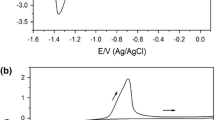Abstract
ZnSe thin films of both p and n conducting types were successfully deposited on transparent conducting glass substrates using an electrochemical deposition technique. Thin films were deposited from an aqueous acidic electrolyte containing \( ZnSO_4 \) and \( H_2 SeO_3 \). Deposition of thin films in a voltage range of 0.0 to −1.0 V was investigated by means of a voltamogram. The most suitable deposition voltage range was found to be −0.48 to −0.62 V for ZnSe in this aqueous medium. The nature of the surface of the conducting glass and the deposited ZnSe layers were studied using atomic force microscopy (AFM). Although the substrate surface was rough and spiky as observed from the AFM studies, electrodeposited ZnSe layers exhibit good crystallinity when compared to MBE grown ZnSe layers on GaAs (1 0 0) surfaces. The C–V depth profiling studies suggest the level of charge carrier concentration to be in the semiconducting region for these thin film materials. Photoluminescence studies were carried out in order to study the energy states in the band gap region and the results indicate the presence of less number of defect levels in comparison with MBE grown ZnSe layers. The best p–n junction devices fabricated with electrodeposited layers to date display a rectification factor of over five orders of magnitude at 1.0 V.
Similar content being viewed by others
References
S. Nakamura, Phys. World Feb. (1998) 31.
A. L. Dawar, P. K. Shishodia and P. C. Mathur, J. Mater. Sci. Lett. 8 (1989) 561.
M. Ei Sherif, F. S. Terra and S. A. Khodier, J. Mater. Sci.: Mater. Electron. 7 (1996) 391.
C. Natarajan, M. Sharon, C. Levy-Clement and M. Neumann-Spallart, Thin Solid Films 237 (1994) 118.
V. Krishnan, D. Ham, K. K. Mishra and K. Rajeshwar, J. Electrochem. Soc. 139 (1992) 23.
A. P. Samantilleke, M. H. Boyle, J. Young and I. M. Dharmadasa, J. Mater. Sci.: Mater. Electron. 9 (1998) 289.
C. Wei and K. Rajeshwar, J. Electrochem. Soc. 139 (1992) L40.
I. M. Dharmadasa, A. P. Samantilleke, J. Young, M. H. Boyle, R. Bacewicz and A. Wolska, J. Mater. Sci.: Mater. Electron. 10 (1999) 441.
K. Singh and J. P. Rai, J. Mater. Sci. Lett. 4 (1985) 1401.
S. M. Mcgregor, I. M. Dharmadasa, I. Wadsworth and C. M. Care, Optical Mater. 6 (1996) 75.
C. D. Lockhande and S. H. Pawar, Phys. Stat. Sol. (a) 111 (1989) 18.
K. Singh and J. P. Rai, Phys. Stat. Sol. (a) 99 (1987) 257.
C. Natarajan, G. Nagomi and M. Sharon, Thin Solid Films 261 (1995) 44.
Author information
Authors and Affiliations
Rights and permissions
About this article
Cite this article
Samantilleke, A.P., Dharmadasa, I.M., Prior, K.A. et al. Development of opto-electronic devices using electrochemically grown thin ZnSe layers. Journal of Materials Science: Materials in Electronics 12, 661–666 (2001). https://doi.org/10.1023/A:1012854101987
Issue Date:
DOI: https://doi.org/10.1023/A:1012854101987




